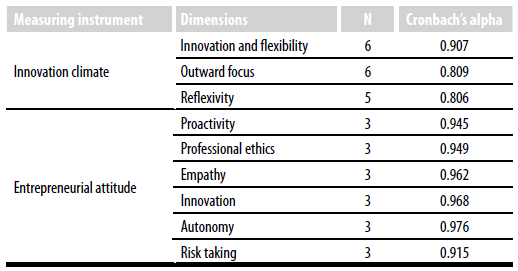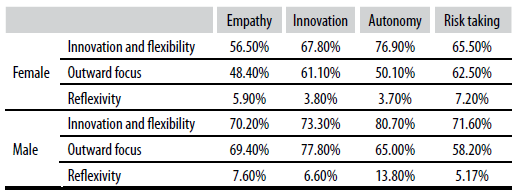Introduction
The concept of entrepreneurship has evolved some theories from the point of view of economics, according to the study carried out by Terán-Yepez and Guerrero-Mora (2020) which presents the contribution of classical theory and neo-classical theory, where they highlight the role of the entrepreneur in the production, exchange and distribution of goods in a competitive market. In addition to this, there are two theories with a valuable contribution to this research framework: The Harvard School Theory and The Schumpeter’s Theory of Innovation; In relation to the first one, entrepreneurship is considered as the result of the combination of internal forces such as experience, knowledge, skills, etc.; as well as external forces such as political, social, economic, cultural factors, etc. that influence on the entrepreneur’s development and the economy. From those factors, thanks to the contribution of Schumpeter’s theory, the importance of innovation in entrepreneurship for solving problems and towards the creation of new goods, methods, markets, supplies and organizations, considering the entrepreneur as a problem solver is highlighted (Mohanty, 2006). Other theoretical contributions to the concept of the entrepreneur’s cover fields such as psychology, sociology and business management are also highlighted (Terán-Yepez and Guerrero-Mora, 2020). In this sense, we highlight one of the most important contributions represented by the culture of innovation as a fundamental element prior to entrepreneurial activity, and therefore, innovation being part of the process of taking risks (Mohanty, 2006). That is why the entrepreneur ‘s cultural and social contexts must be taken into account (North, 1990).
In recent years it has been observed that, thanks to technological advancement, the economic growth of a society generates a higher level of entrepreneurship and innovation (Wang and Fu, 2023). The economic development in countries such as the United States, Germany and China go hand in hand with an improvement in the quality of life in relation to education that leads to innovation and entrepreneurship (Cunningham, 2021; Dong, 2020; Hao et al., 2016). In Peru and all over the world, the development of entrepreneurship must continue to be promoted under a climate that encourages innovation from universities, taking into account the negative impact that the COVID-19 pandemic had. According to Salinas and Osorio (2012), entrepreneurship requires innovation, convergen-ce and integration among universities, states, communities and companies in order to generate productive alternatives by establishing, creating and promoting an entrepreneurial culture based on the development of skills that evoke creativity with social responsibility. Universities play an important role in promoting entrepreneurship (Moreno et al., 2017), since university classrooms can promote spaces where innovation is practiced, encouraged and developed (González, 2019). Training and education along with other psychological traits can characterize an entrepreneur; evidence shows greater entrepreneurship initiatives in the young population (Martinez, 2016). Likewise, a positive and intensive attitude towards entrepreneurship must be generated and promoted. This will give students more chances to start a new company and thus contribute to the development of the economy (Álvarez, 2004).
Worldwide, according to a report prepared by Hill et al. (2022) for the Global Entrepreneurship Monitor (GEM), the entrepreneurs’ attitudes to start a business as a consequence of the COVID 19 pandemic were decreased in relation to their confidence in their own abilities to start a business. In this regard, in 2021 more than one in two entrepreneurs agreed that starting a business had become more difficult in 18 of 47 economies. The level of early age entrepreneurial activity (TEA) also decreased in most countries with 15 economies in which TEA decreased from 2019 to 2020 and then increased in 2021, while in 12 economies, TEA increased from 2019 to 2020, and then, it fell in 2021, so this left a clear majority of economies (22) where TEA levels were lower in 2021 than in 2019. Despite this and according to the results of the GEM 2018-2019 prepared by Serida et al. (2020), Peru is one of the countries with the greatest intention to start a business in Latin America and the world, located in the fourth position in the region with 39.7% of the population willing to start a business, being preceded by Guatemala, Colombia and Chile This means that Peru leads the Latin American ranking with close to 50% of its population interested in entrepreneurship; At a global level, Peru is in eighth place. Even so, it is also characterized by a high rate of discontinuation in entrepreneurship (7.6%), placing it in eighth position worldwide. In spite of this, it is still above the average for the Latin American region (5.3%). However, a worrying point is the low levels of innovation (2.9%), this value has led it to be below the region’s indicator which is 24.7%.
Given this situation and in relation to the entrepreneurial attitude and innovation from the university area in Peru, we can mention the study carried out by Saavedra et al. (2021) as recent contribution. In this study, it is established the importance of knowing the entrepreneurial attitude and capacity that students in the administration program have in order to create their own business. The results showed that 65.6% have an entrepreneurial attitude and 60.3% indicate that they have the ability to create microbusinesses; Furthermore, it was found that both variables present a positive and significant relationship. On the other hand, in the study carried out by Mayuri et al. (2022), the positive and significant relationship between the entrepreneurial attitude and business generation in young university students was concluded in 51.6% agreeing that they have the necessary personal qualities to generate business and 44% motivated to generate business. In another study carried out by Huaraca-García et al. (2021), the positive and significant relationship that exists between social skills and entrepreneurial attitude in students of administrative and accounting sciences was determined, a similar result to that of Gonzales et al. (2022) who demonstrate that there is a positive and significant relationship between these same variables, but in psychology students. There are other studies that deal with entrepreneurial attitude, business creation capacity, entrepreneurial intention and innovation as such, among other similar variables, but with regard to knowing how much an innovative cli-mate can influence the entrepreneurial attitude and how much this relationship can change. Both at the beginning and at the end of the careers of university students, no research was identified either in the Peruvian context or at the international level. For this reason, knowing the influence of the innovation climate on the attitude towards entrepreneurship is very important since, according to the GEM, younger people feel that they are more likely to start a business and take risks, they feel more motivated to make a difference in the world than previous generations as they feel more responsible for current and imminent challenges. Likewise, young people with higher levels of educational attainment are associated with higher levels of entrepreneurial activity because they are more confident in having the skills and abilities to start their own business and the ability to detect opportunities (Hill et al., 2022). In this sense, the university is increasingly aware of the active role it can assume in generating the entrepreneurial spirit in young students towards the development of skills necessary to promote creativity, flexibility, the capacity to adapt and the ability to learn. to undertake (Olmos, 2007). If business education programs are carried out, they could influence the entrepreneurial attitudes of students which would change their way of thinking to create their own opportunities instead of going looking for them (Anderson and Jack, 2008).
In the macro-environmental framework of the International Standard Classification of Education (ISCED) designed by the United Nations Educational, Scientific and Cultural Organization (UNESCO), no particular line is identified where the entrepreneurial major is mentioned. This could be part of the area of social sciences, business education and law, and subarea of business education and administration (Taccari, 2009). However, at a meso- and micro-environmental level, the Continental University guidelines identify the line of institutional research on entrepreneurship and innovation whose field of action is transversal among several faculties, such as the faculty of business sciences where the International Business and Administration degree is (Universidad Continental, 2024).
Therefore, the objective is to determine the level of influence of innovation climate on the students’ entrepreneurial attitude studying International Business and Administration at the different campuses of the Continental University in the face-to-face modality through a quantitative explanatory study which will foster a climate that promotes innovation towards an entrepreneurial attitude, the axis of the University and a pillar for the economic development of the country. It is assumed as a hypothesis that there is a high degree of influence of the innovative climate on the entrepreneurial attitude of university students, both at the beginning and at the end of their university career.
Methods
It is about a study with a descriptive-correlational and explanatory scope because the type of relationship among the study variables with a fact prediction is determined, at the same time, a cross-sectional non experimental designed is used because the research reality is not manipulated, and the data collection was carried out in an only specific period of time (Hernández-Sampieri y Mendoza, 2018).
Participants
About the procedure, a coordination process to request the corresponding academic authority permissions and the professors from some courses of first and last year of the career of Administration and International Business from the Universidad Continental was carried out. The administrators sent the instruments to each participant and they were asked to cooperate voluntarily to answer the scales. The general purpose was explained and a virtual form was given to them, making emphasis that it must be answered individually. Finally, real time data were collected. Once the students sent the answered scales, they were thanked for having participated in the study.
A non-probabilistic sample of 219 volunteer people, oriented by study years and sex, was formed. People’s ages vary between 18 and 24 years old, out of which, 58% (n=127) of participants belong to first year and the remaining 42% (n=92), belong to the fifth study year. 69.86% (n=153) of participants are women, while 30.14% (n=66) of participants are men.
The Student Entrepreneurial Attitude Scale developed by Oliver and Galiana (2015) (see Appendix), consists of 18 items in Likert type format with five answer options; Completely Agree, Agree, Indifferent, Disagree, and Completely Disagree, scoring 1, 2, 3, 4, and 5, respectively. For its application, six dimensions were treated in entrepreneur attitudes: proactivity, professional ethics, empathy, innovation, autonomy, and risk taking.
For each dimension mentioned above, 3 items were established in order to evaluate the entrepreneurial attitudes. The Open Scale of Climate for Innovation developed by Remneland-Wikhamn and Wikhamn (2011) (see Appendix), is made of 17 items in Likert-type format with four options to answer: Definitively False, Mostly False, Mostly True, and Definitively True, scoring 1, 2, 3 and 4, respectively. For its application, three dimensions were treated: innovation and flexibility, outward focus and reflexibility. In the first dimension, 6 items were treated, in the second one 6 items and in the third dimension 5 items were treated in order to evaluate the perception about the climate for innovation.
Methodology
In relation to the innovation climate about entrepreneurship attitude of Administration and International Business students corresponding to the methodology used, each dimension has a maximum score of 100, doing a conversion that does not affect original answers, it just widens them in a clearer span in order to be compared lately. The following equation was used, as follows: Each dimension = (Sum of scores for all items with same dimension X 100) / Maximum answer total score for the dimension.
For the statistical data process, the SPSS version 25.0. A program was taken into consideration through inferential statistics (based on probability theory), the relationship among the research variables was determined according to the normality of data in order to estimate the parameters, analyze and present the results. In research with quantitative approaches, the set of results is analyzed by using statistical methods because the nature of the research is sequentiality and evidence (Hernández-Sampieri y Mendoza, 2018).
To diagnose the prevalence of different entrepreneurial attitudes and the innovation climate in first- and fifth-year students of the university majors mentioned before, diverse descriptive analyses were carried out (mean, medians, standard deviations and asymmetry). To analyze this same objective, in a differential form with respect to sex and year of study, a nonparametric multivariate analysis of variance was carried out. At the same time, medians among values of students between both sexes and first and fifth year of study through the Mann-Whitney test or the Wilcoxon (W-test) test, were also done. This non parametric statistic is used in ordinal or quantitative variables of free distribution, that is to say, it doesn’t have a normal distribution, so that it contrasts the medians of two free distribution independent groups (Rivas-Ruiz et al., 2013). For the validity analysis, the Kaiser-Meyer-Olkin (KMO) sampling tests and Bartlett’ s sphericity test were used; KMO measure is a statistic that indicates the proportion of variance in variables that can be caused by underlying factors; high values near 1,0, generally indicate that a factorial analysis can be useful when processing data, but if this value is lower than 0,50, the results of the factorial analysis won’t be very useful. The Bartlett’s sphericity test indicates that the variables are not related and, therefore, they are not adequate to detect structures and small values. Values lower than 0,05 in the meaningful level indicate that a factorial analysis can be useful for data (IBM, 2022). For the reliability analysis, Cronbach’s coefficient of internal statistic was used. This expresses the degree in which items measure the same variable through homogeneity, being useful to calculate the reliability of an instrument whose items are part of a variable (Virla, 2010). For correlation tests and because the results were nonparametric with ordinal variables of free distribution, the Spearman’s rho statistic was used. This coefficient is a linear association measure that uses ranges and order numbers from each group of subjects, and compares these ranges for non-normal distributions (Martínez et al., 2009). Finally, to identify the degree in which a variable variance or dimension explains another variable or dimension, the r-squared coefficient of determination statistic was applied. This statistic is used to identify the proportion or total variation percentage from a variable with respect to its mean which is explained in the regression (Rodríguez, 2005).
Results
In relation to the validity and reliability of both instruments, the validity test was carried out through the de Kaiser-Meyer-Olkin’s sampling measure adequation method (KMO)and Bartlett’s sphericity. It was observed that both, the innovation climate instrument and (KMO=0.885, X2=2556.35, value-p = 0.0001) the instrument for measuring entrepreneurial attitude, (KMO= 0.967, X2=7147.49, value-p=0.0001) presented very high validity.
TABLE 1. KMO and Bartlett’s test

Note. KMO = Kaiser-Meyer-Olkin’s sampling adequation measure. Statistical results of KMO and Bartlett tests.
The reliability analysis for each dimension through the Cronbach’s alpha statistic from the instruments used was carried out, identifying high reliability in both cases (table 2). Global reliability was α=0.862 for the innovation climate instrument and α=0.990 for entrepreneurial attitude.
About the investigation results, we resume the methodology for its corresponding analysis from the following equation: Rate of each dimension = (Sum of all the scores of all items measuring the same X 100) /maximum answer total score for dimension. It was left as follows, for the case entrepreneurial attitude: 20-35very low, 30-51 low, 52-67 medium, 68-83 high, 84-100 very high; for innovation: 25-43 definitely false, 44-62 mostly false, 63-81 mostly true and 82-100 definitely true. In table 4, the innovation cli-mate valuation averages are presented (IC) as well as the entrepreneurial attitude valuation averages (EA). Referring to administration and international business students, and according to the innovation climate variable, they perceive the innovation and flexibility level as high (X=76.96), according to Patterson et al. (2005) (cited in Remneland-Wikhamn and Wikhamn, 2011, p. 7), this dimension is related to the preparation and answering to new ideas, problem solving and work procedures (not necessarily from outside sources), as well as, assistance and support in the innovation process. This dimension emphasizes on the need for constant opportunity search and value transformation in order to respond to market changes fast. The dimension corresponding to reflexivity also presents a high score (X=74.98), according to Weick, (2001) (cited in Remneland-Wikhamn and Wikhamn, 2011, p. 7). This dimension is a key element for learning and the creation of meaning is closely related to the concept of absorption capacity which means to be able to analyze carefully through a personal introspection process, to connect with thoughts and moods before doing any activity. On the other hand, the outward focus dimension obtained a low score (X=58.86), which means that they have the perception that the university has the capacity of directing their attention to the outside world, specially to clients and the market, in general. This includes capturing opportunities and market trends, as well as, understanding and answering to customers’ needs. It also describes whether the university has a strong or weak climate as an important barrier for innovation. The entrepreneurial attitude was high in all its dimensions.
TABLE 3. IC and EA valuation averages from administration and international business students according to dimensions
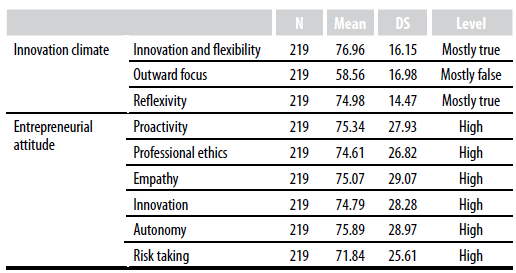
Note. Results of the assessment averages of both variables.
In table 4, it is shown that in all cases innovation and flexibility, outward focus and reflexibility have a weak or very weak correlative relationship with the entrepreneurial attitude dimensions (p<0.05), indicating that not necessarily when there is greater innovation climate, there is greater entrepreneurial attitude, but on the contrary, it has been observed an opposite phenomenon. In order to explain the influence on the dimensions of the innovation climate variable in each dimension belonging to entrepreneurial attitude variable, the results obtained through the r squared determination coefficient are between ranges 1,97% and 7,79%. This means that with results closer to 0; it cannot be determined the presence of a representative influence degree among innovation climate dimensions over entrepreneurial attitude dimensions.
TABLE 4. Relationship between IC and EA from administration and international business students
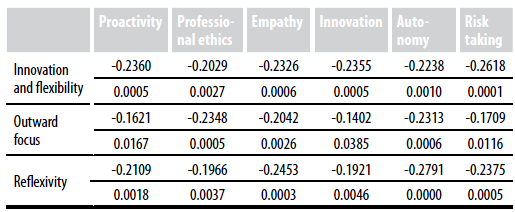
Note. Results of the relationship between both variables.
In relation to the innovation climate perception and entrepreneurial attitude of first and fifth year of administration and international business students, we observe that in Table 5, the comparison of medians between first- and fifth-year students through the Mann-Whitney test or the called Wilcoxon (W-test) test, only statistically significant differences were identified (valor-p=0.0001) in the outward focus dimension in first year students (M=50.00), having a Mostly false opinion and in the fifth year students with a Mostly true opinion (M=66.67) in relation to the university directing their attention to the market. In other dimensions analyzed, there were not significant differences observed. In the case of the other innovation climate variable, perception is qualified as «Mostly true» and in the case of all entrepreneurial attitude variable dimensions, perception is qualified as «Very high». These results were obtained for both first- and fifth-year students.
TABLE 5. Comparison between IC and EA between first- and fifth-year students
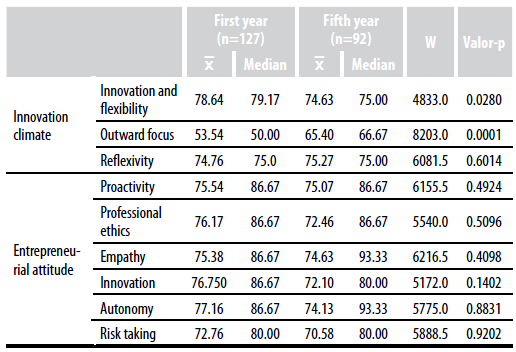
Note. Results of the comparison between the dimensions of both variables according to year of study.
In table 6, we present correlations among dimensions for innovation climate and entrepreneurial attitude according to first- and fifth-year students.
In case of first year students, the innovation and flexibility dimension presents all relations having significant characteristics (valor-p<0.05) and negative ones as well (coefficient of negative correlation) regarding entrepreneurial attitude. The outward focus dimension presents a significant correlation in a negative and low form with the empathy dimension of the entrepreneurial attitude variable (r=-0.2963, p=0.0009). The empathy dimension, according to Monsalve (2013), implies the capacity to understand and be aware of other people’s feelings and emotions which suggests understanding others, service orientation, taking advantage of diversity and political awareness. Also, the outward focus dimension presents a significant correlation in a negative and low aspect regarding the autonomy dimension (r=-0.2161, p=0.0153) from the entrepreneurial attitude variable. This dimension, according to Bernal (2021), is characterized for its influence on personal identity. Entrepreneurship isn’t limited to business development, but it also extends to the acquisition of personal resources to make decisions and perform adequately in all life areas. The reflexivity dimension presents a significant negative correlation regarding the proactivity dimension from the entrepreneurial attitude variable (r=0.2621, p=0.0033), according to López (2010), being proactive does not only mean having initiative, it also implies taking responsibility to make things happen, making decisions on what to do and how to do it at all times; it also presents a significant negative correlation with respect to empathy dimension (r=-0.2963, p=0.0009), autonomy (r=-0.3280, p=0.0002) and innovation (r=-0.2104, p=0.0182), according to OCDE (2018), for students, it means the perception of a significantly different new or improved process from the previous process implemented by the university; it is also the same case for the taking risks dimension (r=-0.2123, p=0.0172) from the entrepreneurial attitude variable, according to Mejía (2006), this is related to the probability of uncertainty loss, variation of results with respect to what was expected, the probability of a threat occurring and the seriousness of its possible consequences or the probability of failure to achieve a given goal.
qqIn case of fifth year students, the innovation and flexibility dimension only presents significant negative and low correlations regarding risk taking (r=-0.2576, p=0.0140) and professional ethics (r=-0.2575, p=0.0140) from the entrepreneurial attitude variable, according to Torres (2016), professional ethics means having a visionary spirit with self-knowledge, innovation and leadership abilities with moral authority, making personal and professional decisions based on ethical and moral principles for economic development with social responsibility towards environment. The outward focus dimension presents all its relations having significant and negative characteristics with respect to the entrepreneurial attitude variable (value-p<0.05). The reflexivity dimension presents a significant negative correlation to professional ethics (r=-0.2566, p=0.0144), autonomy (r=-0.2060, p=0.0494) and risk taking (r=-0.2548, p=0.0151) from the entrepreneurial attitude variable.
To determine how much the result of each dimension of the entrepreneurial attitude variable explains according to the innovation climate variable dimensions regarding to years of study, the results are presented considering significant data through the r-squared coefficient of determination. These results are in ranges from 3,5% and 11,69%. Unfortunately, it cannot be predetermined how representative the degree of influence among the innovation climate dimensions is on the entrepreneurial attitude dimensions.
TABLE 6. Correlation between IC and EA dimensions for first- and fifth-year students
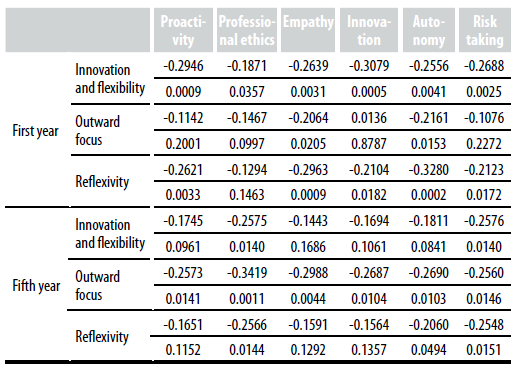
Note. Results of the correlation between the dimensions of both variables according to year of study.
In relation to the perception between innovation climate and entrepreneurial attitude of administration and international business students regarding to sex, in Table 7, we can observe a comparison of the medians among students’ scores according to sex through the Mann-Whitney test or the Wilcoxon (W-test) test. In this case, only statistically significant differences related to women’s autonomy were identified (value-p=0.0039). This presented a very high score (M=93.0). At the same time, men also had a high score (M=80.0). In other dimensions, statistical differences were not observed. Other qualifications regarding the innovation climate variable dimensions range between «Mostly true» and «Definitely true» perceptions, other averages from the entrepreneurial attitude variable dimensions range between a high and a very high score.
TABLE 7. Comparison between IC and EA dimensions of students according to their sex
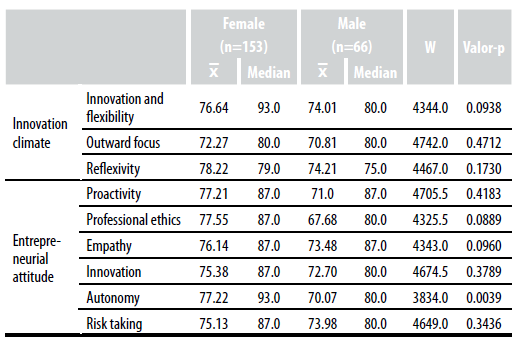
Note. Comparative results between the dimensions of both variables according to sex.
In Table 8, we present the correlations between innovation clima-te and entrepreneurial attitude dimensions of students according to their sex. With respect to women’s results, the innovation and flexibility dimension presents a significant positive correlation regarding to empathy (r=0.7515, p=0.0001), innovation (r=0.8233, p=0.0001), autonomy (r=0.8768, p=0.0001) and risk taking (r=0.8093, p=0.0001) from the entrepreneurial attitude variable. This means the greater the perception of innovation climate and flexibility is, the greater the entrepreneurial attitude regarding empathy, innovation, autonomy and risk taking. The outward focus dimension presents a significant positive correlation with respect to empathy (r=0.6958, p=0.0001), innovation (r=0.7817, p=0.0001), autonomy (r=0.7080, p=0.0001) and risk-taking dimensions (r=0.7905, p=0.0001) from the entrepreneurial attitude variable which means that the greater perception of an outward focus is, the greater the entrepreneurial attitude regarding to empathy, innovation, autonomy and risk taking becomes. The reflexivity dimension presents a significant negative correlation with respect to empathy (r=-0.2439, p=0.0026), innovation (r=-0.1959, p=0.0157), autonomy (r=-0.1916, p=0.0182) and risk-taking dimensions (r=-0.2678, p=0.0010) from the entrepreneurial attitude variable, this means that the greater the perception about a climate based on reflexivity is, the lower the entrepreneurial attitude regarding empathy, innovation and autonomy becomes. With respect to men’s case, innovation and flexibility dimension presents a significant positive correlation with respect to empathy (r=0.8380, p=0.0001), innovation (r=0.8560, p=0.0001), autonomy (r=0.8984, p=0.0001) and risk-taking dimensions (r=0.8463, p=0.0001) from the entrepreneurial attitude variable, so the greater the innovation and flexibility climate perception is, the greater the entrepreneurial attitude regarding empathy, innovation, autonomy and risk-taking gets. The outward focus dimension presents a significant positive correlation with respect to empathy (r=0.8332 p=0.0001), innovation (r=0.8821, p=0.0001), autonomy (r=0.8064, p=0.0001) and risk-taking dimensions (r=0.7627, p=0.0001) from the entrepreneurial attitude variable. According to this, the greater an outward approach perception is, the greater the entrepreneurial attitude regarding empathy, innovation, autonomy and risk taking is. The reflexivity dimension presents a significant negative correlation with respect to empathy (r=-0.2753, p=0.0264), innovation (r=-0.2563, p=0.0388) and autonomy (r=-0.3712, p=0.0028) from the entrepreneurial attitude variable which means that the higher the perception of a climate based on reflexivity is, the lowest the entrepreneurial attitude regarding empathy, innovation and autonomy is.
TABLE 8. Correlation between IC and EA dimensions of students according to their sex
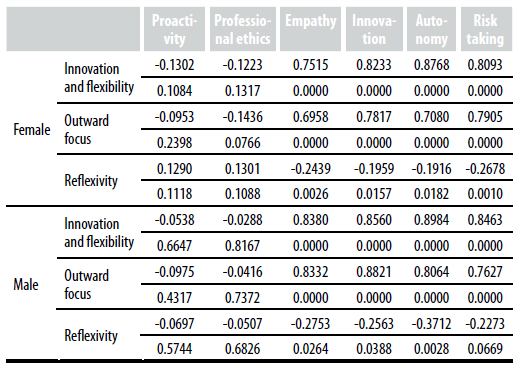
Note. Results of the correlations between the dimensions of both variables according to sex.
In table 9, we present the explanatory results through r-squared coefficient of determination between the innovation climate and the entrepreneurial attitude dimensions according to sex. In this table, only results according to significance presented in Table 8 have been considered, thus, the results regarding proactivity and professional ethics dimensions are not considered. With respect to women’s results, 76,9% of the autonomy variance, 67,8% of the innovation variance and 65,5% of the risk-taking variance can be explained due to the perception of an innovation and flexibility climate. At the same time, 62,5% of the risk-taking variance and 61,1% of the innovation variance can be explained due to an outward focus climate. With respect to men’s results, 80,7% of the autonomy variance, 73,3% of the innovation variance and 71,6% of the risk-taking variance can be explained due to the perception of an innovation and flexibility climate. At the same time, 77,8% of the innovation variance, 69,4% of the empathy variance and 65% of the autonomy variance can be explained due to the perception of an outward focus.
In case of both sexes, according to the most representative results and considering significant and positive correlations in all cases, the innovation and flexibility dimension from the innovation climate variable influences on autonomy, innovation and risk taking dimensions from the entrepreneurial attitude variable in a representative form which means that a climate where generation of new ideas, problem solving and innovative procedures regarding value as a part of the university environment are promoted, influences on students’ attitude to reinforce personal identity towards the development of new and improved processes and readiness to action with possible loss, assuming consequences in order to achieve their entrepreneurial objectives. In addition to this, the outward focus dimension from the innovation climate variable influences on the innovation dimension from the entrepreneurial attitude variable in a representative form. That is to say that the perception about the university having the capacity to direct their attention to the market in order to capture opportunities influences on their attitude towards the proposal or development of new and improved products or processes as a part of their entrepreneurial profile.
Discussion
The motivation to develop this study is to provide a useful diagnosis about innovation and entrepreneurship as a base to evaluate activities that promote entrepreneurship implemented in a university. It would be advisable to increase the prevalence of students’ entrepreneurial attitudes more preferably directed towards self-employment, but becoming drivers of an innovation-promoting climate in order to achieve greater results. In order to do so, we set ourselves the following goal: to determine the level of influence of the innovation climate on the entrepreneurial attitude from the students majoring in administration and international business in Universidad Continental in face-to-face mode, on one hand, according to the first and fifth study years and on the other hand, according to the sex of students.
The most important results obtained in this research are, as follows: According to the valuation averages from Innovation Climate (IC) and Entrepreneurial Attitude (EA), students perceive innovation and flexibility and reflexivity levels as high, but the outward focus is perceived as low by students. About their correlations, all IC dimensions present weak or very weak negative correlation with respect to entrepreneurial attitude dimensions EA, indicating that not necessarily the greater the innovation climate is, the greater the entrepreneurial attitude is. This is reinforced with the analysis done through the r-squared coefficient of determination, obtaining results closer to 0 which demonstrates a low influence degree among IC dimensions over EA dimensions. In a related field, in the case of Chilean students, it was found that there is a direct effect of education and entrepreneurial mindset on the entrepreneurial intention, giving importance to the need of promoting a positive institutional environment in order to encourage such intention (Valenzuela-Keller et al., 2022). In addition to this, in the case of Rumanian students, risk taking, proactivity and entrepreneurial attitude dimensions are positively related to the entrepreneurial intention where the entrepreneurial university environment drives innovation (Trif et al., 2022). Considering that these are different environments, it is demonstrated that there is a positive relationship among roles to promote an innovative environment over the development of attitudes towards entrepreneurship, all this taking into consideration that the context of the investigation was during COVID-19 pandemic, being the university responsible to promote the achievement of knowledge and abilities which improve students’ innovation capacity facing the external challenges presented. With respect to the relationship between intention and entrepreneurial attitude, in the study carried out by Arango-Botero et al. (2022), having as context Colombian university students, it was concluded that there are not differences between the entrepreneurial climate and the syllabus learning, but there were some identified differences between intention and entrepreneurial attitude. This result is different from the study done by Al-Mamary and Alshallagi (2022), in which a strong relationship between entrepreneurial intention and greater proactivity, autonomy, risk taking and innovation capacity were identified as a part of the entrepreneurial attitude in university students from Arabia, implying that there can be differences according to the context and on the way how intention and entrepreneurial attitude are perceived and the university role to promote them. In relation to the perception of both variables between first and last year students of the university career, only one difference in the outward focus (the university must direct their attention to the market) was observed. It has to do with their opinions about it, answering as «Mostly false» by first year students and «Mostly true» by fifth year students. Regarding other dimensions of both variables, the scores are mostly favorable for both of them. With respect to the correlations between both years of study, the most outstanding fact is that for first year students, the innovation and flexibility dimension presents all correlations as significant and negative with respect to the EA variable. Something similar happens with fifth year students, but with respect to the outward focus dimension instead, and whose correlations are also significant and negative with respect to the EA variable. This is reinforced through the analysis carried out through the r-squared coefficient of determination with low percentage results which indicates a low influence degree among the innovation climate dimensions on the entrepreneurial attitude dimensions according to years of study.
In relation to the perception of both variables according to the sex of students, only significant differences related to autonomy among women were found. These presented a very high score for both men and women; other scores are mostly favorable for both variables. Referring to the correlations between the dimensions in both variables, both men and women cases, the innovation and flexibility dimension and the outward focus dimension present a positive and significant correlation with respect to empathy, innovation, autonomy and risk-taking dimensions from the EA variable, but for both sexes, the reflexivity dimension presents a negative significant correlation with respect to empathy, innovation and autonomy dimensions from the EA variable. This is reinforced by doing the r-square coefficient for determination analysis to the students’ answers with results closer to 1. According to the most representative results, the flexibility and innovation dimension from the IC variable influences in a higher degree on autonomy, innovation and risk-taking dimensions from the EA variable. In another context, according to the study carried out by Ramon-Dangla et al. (2022) in Spanish university students, there is a greater prevalence of women to take new challenges and risks and accept them when undertaking or starting a business with respect to men. On the other hand, in the case of both sexes, the outward focus dimension from the IC variable influences in a higher degree on the innovation variable from the EA variable.
University institutions must promote entrepreneurship with models that provide a positive image of entrepreneurship in which interaction between experienced entrepreneurs and students is important and in order to strengthen their intention to generate business (Jena, 2020). It is also very important to strengthen the construction of a practical classroom through a curriculum combining innovation and entrepreneurship to emphasize entrepreneurship without neglecting innovation (Zhou and Zhou, 2022), so that education with innovation and entrepreneurship are the main form to cultivate talents in order to cope with market economy, being important to identify university professors who have the ability to reach such goals (Li, 2021).
Considering the situation of the COVID-19 pandemic, which generated significant economic changes in several countries, there is greater interest in being an entrepreneur, with greater acceptance by society and a greater aptitude for business activity (Lopes et al., 2021).
Conclusions
First of all, and according to the averages obtained from the Innovation Climate (IC) ratings, students perceive the level of innovation and flexibility as high, as well as the corresponding level of reflexivity, but they perceive the level of outward focus that the university has as low. Regarding the entrepreneurial attitude (EA), the rating was high in all dimensions. Based on the correlational analysis, it is concluded that not necessarily the greater the innovation climate, the greater the entrepreneurial attitude, or can a representative degree of influence between the dimensions of each variable be evident, neither. Secondly, regarding the perception of each variable between first and fifth year students, statistically significant differences were identified in the outward focus dimension between first year students with a majority disagreeing opinion and fifth year students. with a majority opinion in agreement about how the university directs its attention to the market. Thirdly, the correlations between the dimensions of each variable, among first-year students show that the innovation and flexibility dimension presents all the relationships as significant and negative with respect to the entrepreneurial attitude variable and, in other cases, these are presented as significant and negative, but low rather than high. With respect to fifth-year students, the dimension corresponding to innovation and flexibility presents only a low significant negative correlation with respect to the risk-taking and professional ethics dimensions of the entrepreneurship variable. On the other hand, the outward focus dimension presents significant and negative results with respect to the dimensions corresponding to the entrepreneurial attitude variable; It cannot be determined how much these results corresponding to the dimension in each variable explain, nor can it be explained how representative the degree of influence between them is.
Fourthly, regarding the perception corresponding to innovation cli-mate and students’ entrepreneurial attitude according to their sex, only statistically significant differences corresponding to autonomy were identified between women with a very high score and men with a high score. In the other study cases, no significant differences were observed. Furthermore, regarding the correlations between the dimensions of each variable, in both men and women, the greater the perception of a climate of innovation, flexibility and orientation towards the outside, the greater the entrepreneurial attitude towards empathy, innovation, autonomy and risks’ taking. However, both also agree that the greater the perception of a climate based on reflexivity, the lower the entrepreneurial attitude towards empathy, innovation and autonomy.
This research aims to serve as a reference background for other studies on the relationship between innovation climate and entrepreneurial activity in the university environment. From this research directed to 219 students studying International Business and Administration at the Continental University, it was determined that neither necessarily the greater the climate of innovation, the greater the entrepreneurial attitude, nor can a degree of representative influence between the dimensions of each variable be present. This research helps researchers understand the importance of promoting a climate towards the promotion of innovation to strengthen the entrepreneurial spirit in students from university classrooms. Among the limitations, we can mention the context of the COVID-19 pandemic, which involved certain general restrictions, as well as the use of convenience sampling, requiring caution in generalizing the results. To address these limitations, we adhered to the rules set by the university institution. Additionally, future research should consider examining other university students in different geographical contexts, both within and outside our country, as well as accounting for the type of institution, whether public or private, and even in the field of technical and professional studies. Another promising avenue for future research would be to conduct studies using statistical models that explore other dimensions, such as intentions, self-efficacy, and changes in attitudes throughout the years of study, and how these may be influenced by the innovative climate fostered by the university.














